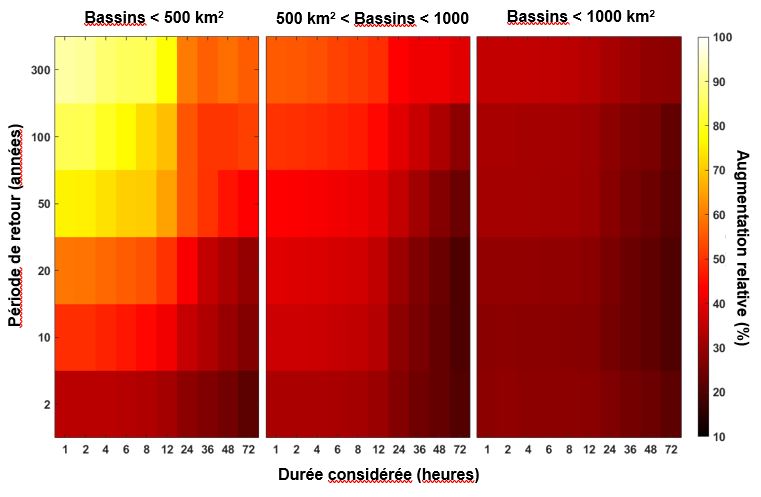Hydrological hazards and extreme rains
The amplification of precipitation and flow extremes in a warmer climate is greater for small watersheds, for shorter durations, and for frequent recurrences. The results show the importance of considering the size of watersheds in assessing vulnerability to increased extreme summer and fall precipitation.
Project details
Principal(s) investigator(s)

Context
Quebec is influenced by two main types of flooding: floods related to the melting of snow cover in spring, and those related to extreme precipitation in the summer or fall. It is expected that the former will gradually decrease as the climate warms in southern Quebec, while the latter will increase in frequency and magnitude. Fall and summer floods are due exclusively to extreme rainfall. These floods can reach their peak in small and medium watersheds (< 500 km2) when the size of the basin and the meteorological system are comparable. To properly model high water events in such basins, a sub-daily calculation time step is necessary. This presents particular challenges due to the sub-daily data available and the importance of properly quantifying the peaks of extreme high water events. Furthermore, the limited length of the observation series presents an additional challenge for estimating floods with a long return period.
Objective(s)
The project had two main objectives, A and B, which are briefly described below.
-
OBJECTIVE A: Set up a hydrological modelling chain at the sub-daily scale to study the impacts of the modelling time step on the reproduction of extreme summer and fall high water events.
The aim was to analyze and compare the performance of distributed and global hydrological models on small basins at variable sub-daily time steps, as well as at variable spatial scales in the case of distributed models. -
OBJECTIVE B: Study the impact of natural variability and climate change on the hydrological risk associated with extreme rain events on small watersheds in Bavaria and Quebec.
The aims were to validate the high spatial and temporal resolution outputs of the ClimEx large ensemble for hydrological modelling with a sub-daily time step, to develop a method for correcting bias with sub-daily time steps that is robust for precipitation extremes, and to assess the impact of climate change on extreme high water events in summer and fall and of natural variability on the determination of extreme high water events.
Methodology
This project presents an approach combining various hydrological models used at sub-daily time steps, and with different spatial resolutions in the case of distributed models. These models used observed meteorological data as well as data from the ClimEx large ensemble to study high water events associated with extreme precipitation for the basins of southern Quebec, in current and future climates. This project implemented three hydrological models (GR4J, Wasim, Hydrotel) at different spatial and temporal resolutions in experiments on databases varying between 6 and 339 watersheds.
Results
The main results of this study are summarized in the figure below, which shows the average relative increase (%) in extreme high water events in 133 watersheds as a function of the duration and return period, for three watershed size classes. More specifically, hydrological modelling work made it possible to establish the following main points:
-
An increase in extreme precipitation and flows is observed in all watersheds, for all durations and return periods.
-
The increase in extremes (precipitation and flow) is greatest in small watersheds, for short durations and for long return periods. Relative increases are greater for flow than for precipitation.

Benefits for adaptation
Benefits for adaptation
The amplification of precipitation and flow extremes in a warmer climate is greater for small watersheds, for shorter durations, and for frequent recurrences.
The results show the importance of considering the size of watersheds in assessing vulnerability to increased extreme summer and fall precipitation. Small watersheds (< 500 km2), a size class that includes all urban areas, will be disproportionately affected by future increases in extreme precipitation.
Scientific publications
Funding


Other participants
-
Hydro-Québec
-
Ministère de l’Environnement, de la Lutte contre les changements climatiques, de la Faune et des Parcs
-
Université du Québec à Montréal (UQAM)
-
Université de Sherbrooke
-
École de technologie supérieure (ÉTS)
Related projects
400049